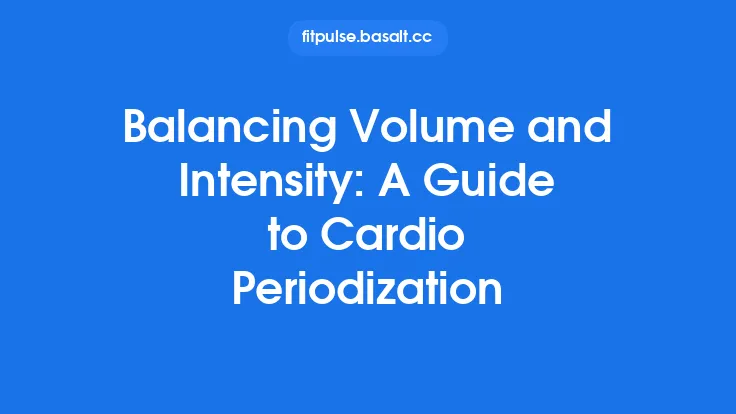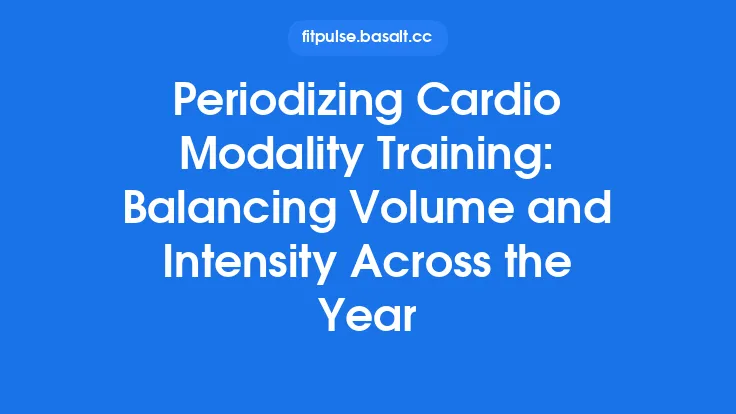When designing a training program, the most powerful lever you have is the ability to align the work you prescribe with the athlete’s—or your own—capacity to recover. Volume (the total amount of work) and intensity (the relative difficulty of each effort) are not static numbers; they are dynamic variables that must be continuously tuned to the ever‑changing state of the nervous system, musculoskeletal tissues, and metabolic reserves. By learning how to read the body’s recovery signals and translate them into concrete adjustments in volume and intensity, you can sustain steady progress, avoid chronic fatigue, and reduce the risk of injury.
Assessing Individual Recovery Capacity
Recovery capacity is the sum of physiological, psychological, and lifestyle factors that determine how quickly an individual can replenish the resources depleted by training. While genetics set a baseline, the day‑to‑day fluctuations are largely modifiable.
| Domain | Primary Components | Typical Assessment Tools |
|---|---|---|
| Neuromuscular | Central drive, motor unit recruitment, muscle contractile properties | Counter‑movement jump (CMJ) height, isometric mid‑thigh pull peak force, sprint speed |
| Metabolic | Glycogen stores, oxidative capacity, hormonal milieu | Blood glucose, lactate clearance rates, cortisol/testosterone ratios |
| Autonomic | Sympathetic‑parasympathetic balance | Heart‑rate variability (HRV), resting heart rate, baroreflex sensitivity |
| Psychological | Mood, motivation, perceived stress | Profile of Mood States (POMS), Daily Stress Questionnaires, subjective wellness scores |
| Lifestyle | Sleep quantity/quality, nutrition, alcohol, travel | Sleep trackers, food logs, alcohol consumption diaries |
A comprehensive recovery profile combines objective data (e.g., HRV, CMJ) with subjective inputs (e.g., sleep quality rating). The goal is not to achieve perfect scores every day but to identify trends and outliers that signal a shift in recovery capacity.
Key Indicators of Recovery Readiness
- Heart‑Rate Variability (HRV) Trends
A sustained drop of >10 % from baseline over 2–3 consecutive mornings often precedes performance decrements. Conversely, a stable or rising HRV suggests adequate parasympathetic recovery.
- Neuromuscular Performance Fluctuations
A decline of >2–3 % in CMJ height or a slower sprint split relative to the previous week can indicate residual fatigue in the central nervous system.
- Subjective Wellness Scores
Elevated scores on fatigue, muscle soreness, or stress scales (≥7 on a 10‑point scale) are early warning signs that the current training load may be exceeding recovery.
- Hormonal Markers
A cortisol‑to‑testosterone ratio that exceeds 0.8 for several days can reflect catabolic stress, especially when paired with other markers.
- Sleep Disruption
Consistently sleeping <6 hours or reporting poor sleep quality (>2 on a 5‑point scale) reduces glycogen repletion and impairs protein synthesis.
When two or more of these indicators move in a negative direction, it is prudent to adjust volume, intensity, or both before the next training session.
Frameworks for Matching Load to Recovery
1. Recovery‑Based Load Scaling (RBLS)
RBLS converts a composite recovery score (CRS) into a scaling factor applied to the planned volume and intensity.
CRS = (HRV_z + CMJ_z + Wellness_z) / 3
Load Factor (LF) = 1 + (CRS × 0.05)
- CRS > 0 → LF > 1 → increase volume/intensity (up to +10 %).
- CRS < 0 → LF < 1 → decrease volume/intensity (down to –15 %).
The factor is applied proportionally: if the original plan called for 5 sets of 5 reps at 80 % 1RM, a LF of 0.90 would adjust the load to 72 % 1RM while keeping the set/rep scheme, or alternatively reduce the sets to 4 while maintaining the original load.
2. Dynamic Autoregulatory Periodization (DAP)
DAP integrates a weekly “Recovery Buffer” (RB) that is added to or subtracted from the planned training stress score (TSS). The RB is calculated from the previous week’s recovery metrics.
RB = Σ (ΔHRV_z + ΔCMJ_z + ΔWellness_z) × 5
Adjusted TSS = Planned TSS + RB
A positive RB (recovery gains) permits a higher TSS, while a negative RB forces a reduction. This method preserves the overall periodization structure (e.g., linear, undulating) but allows the magnitude of each session to flex with recovery.
Practical Strategies for Volume Adjustments
| Situation | Adjustment | Rationale |
|---|---|---|
| Elevated soreness + low HRV | Reduce total sets by 15–20 % or replace one high‑volume day with a technique‑focused session (e.g., 3 × 5 at 60 % 1RM). | Lowers mechanical stress while maintaining movement patterns. |
| Consistently high HRV and low perceived fatigue | Add an extra set to the primary lift or introduce a supplemental accessory block (e.g., 3 × 12 for hamstrings). | Capitalizes on surplus recovery capacity to increase stimulus. |
| Travel or disrupted sleep | Convert a heavy‑volume day into a “maintenance” day: keep the same exercises but cut volume in half and increase rest intervals. | Reduces cumulative fatigue without compromising skill retention. |
| Progressive overload plateau | Implement a “volume‑step” where you increase total weekly volume by 5 % for two weeks, then deload. | Provides a controlled overload stimulus while respecting recovery cycles. |
Tip: When cutting volume, prioritize preserving intensity on the main lifts. The nervous system adapts more robustly to intensity than to sheer volume, especially for strength‑oriented goals.
Practical Strategies for Intensity Adjustments
| Situation | Adjustment | Rationale |
|---|---|---|
| Drop in neuromuscular performance (CMJ ↓) + high fatigue | Decrease load by 5–10 % and increase reps per set (e.g., 5 × 6 at 75 % 1RM). | Reduces central nervous system demand while still providing muscular tension. |
| High HRV, low stress, strong performance | Increase load by 2–5 % while keeping reps constant, or add a “top set” at 90 %+ 1RM. | Exploits heightened readiness to stimulate strength gains. |
| Hormonal catabolic trend (high cortisol/testosterone ratio) | Shift to sub‑maximal loads (70–75 % 1RM) with higher rep ranges (8–12) for a week, then reassess. | Lowers systemic stress while maintaining hypertrophic stimulus. |
| End‑of‑cycle taper | Reduce intensity to 60–70 % 1RM and focus on speed/power work (e.g., 3 × 3 at 50 % 1RM with maximal velocity). | Allows recovery of high‑threshold motor units while preserving neuromuscular priming. |
Tip: When adjusting intensity, keep the relative effort (RPE) within a narrow band (e.g., 7–8) to ensure the session remains challenging despite load changes.
Integrating Autoregulatory Tools
- Velocity‑Based Training (VBT)
Use a linear position transducer to monitor bar speed. If mean velocity on the first set falls >5 % below the athlete’s established baseline, automatically reduce the load for the remaining sets.
- Repetitions‑In‑Reserve (RIR) Check‑Ins
After each set, ask the lifter to estimate RIR. If the reported RIR is consistently higher than the target (e.g., 2 RIR when aiming for 1 RIR), lower the load or cut the set count.
- Session RPE (sRPE) Scaling
Compute the session’s training load as `Load = sRPE × Duration (min)`. If the weekly cumulative load exceeds the recovery‑adjusted threshold (derived from RBLS), schedule a deload or active‑recovery day.
- Daily HRV‑Guided Warm‑Up
On days with HRV > 1 SD above baseline, incorporate a higher‑intensity warm‑up (e.g., 3 × 3 at 85 % 1RM). On low‑HRV days, keep the warm‑up sub‑maximal (e.g., 2 × 5 at 60 % 1RM).
These tools provide real‑time feedback, allowing the program to adapt on a session‑by‑session basis rather than relying solely on pre‑planned macro‑cycles.
Periodization Models that Prioritize Recovery
| Model | Core Principle | How Recovery Is Embedded |
|---|---|---|
| Undulating (Daily‑Undulating) with Recovery Buffers | Vary intensity and volume each session. | Each week includes a “low‑stress” day (e.g., 60 % 1RM, 3 × 12) that serves as a built‑in recovery buffer. |
| Block Periodization with Deload Blocks | Concentrated emphasis blocks (strength, hypertrophy, power). | After each 3‑4 week block, a 1‑week deload reduces both volume (by 40 %) and intensity (by 30 %) to replenish capacity. |
| Flexible Autoregulatory Periodization (FAP) | Pre‑planned waveforms but with “flex days” that can be swapped based on recovery scores. | If recovery metrics dip, a high‑intensity day can be replaced with a technique or mobility day without breaking the overall wave pattern. |
| Reverse Linear (Volume‑First, Intensity‑Later) with Adaptive Taper | Start with higher volume, gradually shift to higher intensity. | The taper phase is lengthened or shortened based on the cumulative recovery score, ensuring the athlete peaks with optimal freshness. |
Choosing a model that inherently includes recovery checkpoints reduces the need for ad‑hoc adjustments and creates a more predictable training environment.
Case Studies Illustrating Adaptive Adjustments
Case 1: Competitive Powerlifter (Intermediate, 28 y)
- Baseline: 4‑day split, 5 × 5 at 80 % 1RM for squat, bench, deadlift; accessory volume 12 sets total.
- Recovery Trend: HRV dropped 12 % for three consecutive mornings after a heavy meet‑prep week; CMJ fell 4 %.
- Adjustment: Applied RBLS (CRS = –0.6 → LF = 0.97). Reduced squat volume from 5 × 5 to 4 × 5 and lowered load to 78 % 1RM for that week. Bench intensity was kept but sets reduced from 5 × 5 to 4 × 5. Added a mobility‑focused session on the fourth day.
- Outcome: Recovery metrics rebounded within a week; performance on the subsequent meet‑day improved by 2.5 % in total lift.
Case 2: Recreational Runner (Female, 45 y)
- Baseline: 3‑day run‑centric program, weekly mileage 30 km, one day of hill repeats (8 × 30 s at 90 % max HR) and two steady‑state runs.
- Recovery Trend: Sleep averaged 5.5 h/night, HRV fell 15 % after a travel week; perceived stress rose to 8/10.
- Adjustment: Implemented a “Recovery Week” where hill repeat intensity was cut to 70 % max HR and volume reduced to 4 × 30 s. Total mileage dropped to 20 km, with an added yoga session.
- Outcome: HRV returned to baseline within 5 days; subsequent weeks saw a 10 % increase in weekly mileage without further HRV decline.
These examples demonstrate that modest, data‑driven tweaks can preserve or even enhance performance while respecting the body’s recovery limits.
Common Pitfalls Specific to Recovery‑Based Programming
- Over‑reliance on a Single Metric
Using only HRV or only subjective soreness can mislead; a multimodal approach is essential.
- Delayed Response to Negative Trends
Waiting more than 48 hours after a clear dip in recovery markers before adjusting load often results in accumulated fatigue.
- Excessive Volume Reductions
Cutting volume by >30 % in a single session can erode technical proficiency and muscular endurance; aim for incremental changes.
- Neglecting Lifestyle Factors
Adjustments in the gym are futile if sleep hygiene, nutrition, or stress management remain poor.
- Treating Recovery Adjustments as “Punishments”
Framing deloads or lighter days as setbacks reduces athlete motivation; present them as strategic tools for long‑term gains.
Putting It All Together: A Step‑by‑Step Workflow
- Collect Baseline Data
- Record HRV, CMJ, sleep, nutrition, and wellness scores for at least 7 days.
- Define Recovery Thresholds
- Set acceptable ranges (e.g., HRV within ±5 % of baseline, CMJ within ±2 %).
- Plan the Macro‑Cycle
- Choose a periodization model that includes built‑in recovery days.
- Daily Check‑In (Morning)
- Measure HRV, note sleep quality, and complete a brief wellness questionnaire.
- Compute Composite Recovery Score (CRS)
- Apply the RBLS formula or a similar weighting system.
- Adjust Session Variables
- If CRS < 0, apply the Load Factor to reduce volume/intensity.
- If CRS > 0, consider a modest increase or maintain the plan.
- In‑Session Autoregulation
- Use VBT or RIR to fine‑tune load on the fly.
- Post‑Session Review
- Record sRPE, any deviations from planned load, and immediate fatigue.
- Weekly Review
- Summarize trends, update thresholds if needed, and plan the next week’s recovery buffer.
- Iterate
- Repeat the cycle, allowing the program to evolve with the athlete’s changing recovery capacity.
By embedding this systematic loop into any training regimen, volume and intensity become responsive levers rather than rigid prescriptions. The result is a training environment that respects the body’s natural healing processes, maximizes adaptation, and sustains long‑term progress.





